Monday, July 27, 2015
Vascular contributions to dementia: A path to prevention
Rebecca F. Gottesman, MD PhD
Associate Professor of Neurology and Epidemiology
Johns Hopkins University
What is Vascular Dementia?
- Also called “Multi-infarct dementia”; other types include subcortical vascular dementia, genetic vascular dementias (CADASIL)
- Classically defined as rapid onset, stepwise progression of symptoms
- Sometimes occurring after a stroke, but often not
- Diagnosis requires cognitive disorder AND either clinical stroke or brain vascular disease by neuroimaging (Gorelick et al., 2011)
- Patients often have problems with attention and executive function; memory may not be affected
- Clinically it is the second leading cause of dementia (~20% of dementia cases), occurring in 14.6 per 1000 person-yrs (vs 19.2 for AD) (Fitzpatrick et al., 2004)
Vascular contributions to dementia may be relevant in a much larger percentage of patients with dementia
Vascular and AD overlap: Autopsy evidence
- Between 55-80% of AD patients have coincident vascular changes in the brain (Bangen et al., Alzheimers & Dementia 2015; Toledo et al., Brain 2013)
- Multiple studies have found less AD neuropathological changes (plaques, tangles) in patients with vascular changes for an equivalent level of cognitive impairment
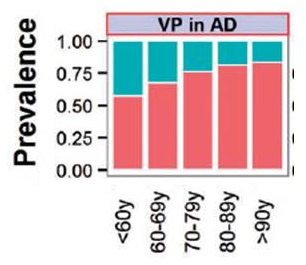 |
Modified from Toledo et al, Brain 2013
(VP: Vascular Pathology; AD: Alzheimer's Disease) |
Possible explanations for a vascular/ AD connection
- Vascular disease and Alzheimer’s changes are additive, leading to worse cognition when both are present, OR
- Vascular disease directly leads to AD neuropathological changes
Mechanisms for a vascular/ AD interaction
- Vascular risk factors lead to alterations in cerebral blood vessels and can lead to low cerebral blood flow, especially in the white matter of the brain
- The blood brain barrier can be disrupted in the presence of vascular disease
- Role of the neurovascular unit: Amyloid-ß itself may directly damage blood vessels, further worsening cerebral blood flow (Iadecola)
- Vascular disease may make clearance of amyloid-ß harder; the “glymphatic system” is around blood vessels and helps remove brain waste (Nedergaard)
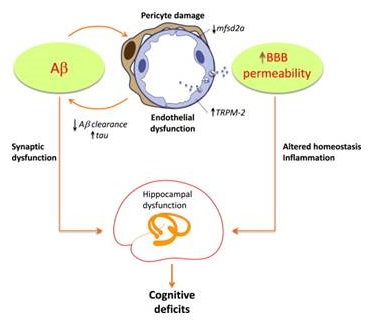 |
| Iadecola, Neuron 2015 |
What do we mean by “vascular disease”?
- Vascular contributions to dementia include:
- Vascular risk factors (hypertension, diabetes, smoking, high cholesterol)
- Microvascular markers (retinal microvascular changes)
- Macrovascular markers (carotid artery disease)
- Clinical strokes
- Brain changes on MRI or on autopsy
- Brain infarcts
- White matter ischemic changes
- Microbleeds
- Associations between vascular risk factors and cognitive decline
- Associations between stroke and cognitive decline
- Associations between vascular risk factors, brain MRI changes and cognitive decline
Hypertension and Diabetes are Each Associated with Steeper Cognitive Decline
| Figure 2. Adjusted Association of Visit 2 (1990-1992) Systolic Blood Pressure Categories and Linear Systolic Blood Pressure With 20-Year Cognitive Change Among Whites |
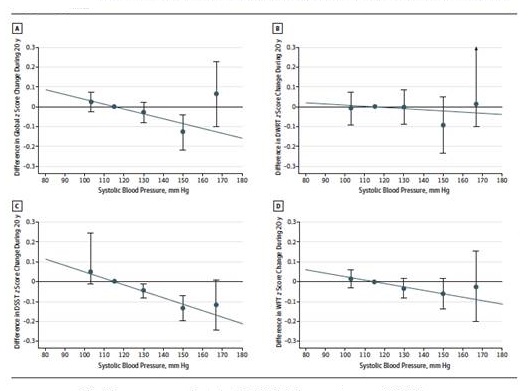 |
| Gottesman et al., JAMA Neurology 2014 |
| Figure 2. Difference in global cognitive Z score decline by clinical category of HbA1C level compared with decline in persons without diabetes and HbA1C level <5.7%. |
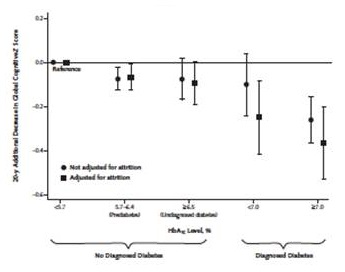 |
| Rawlings et al., Ann Intern Med 2014 |
Worse cognitive performance noted after stroke (REGARDS study)
| Figure 2. Predicted mean Change in Cognitive Function Test Scores Before and After Acute Stroke at Year 3: REGARDS Study, 2003-2013 |
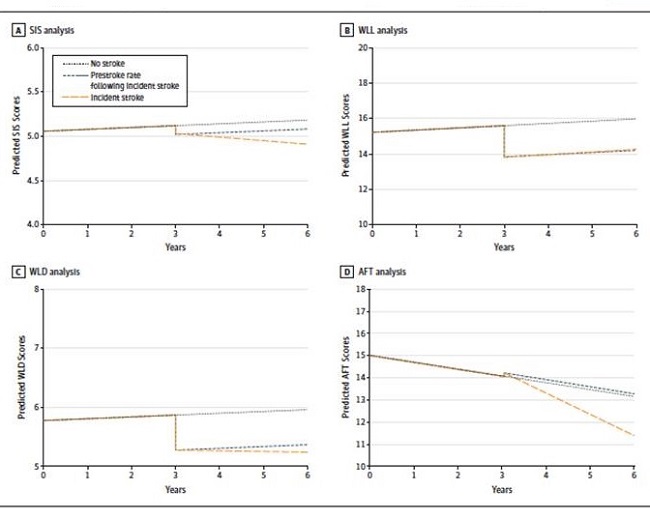 |
| From Levine et al., JAMA 2015 |
Blood Pressure and White-Matter Disease Progression in a Biethnic Cohort
Atherosclerosis risk in Communities (ARIC) Study
Rebecca F. Gottesman, MD, PhD; Josef Coresh, MD, PhD; Diane J. Catellier, DrPH; A. Richey Sharrett, MD, DrPH; Kathryn M. Rose, PhD; Laura H. Coker, PhD; Dean K. Shibata, MD; David S. Knopman, MD; Clifford R. Jack, MD; Thomas H. Mosley, Jr, PhD
 |
| Stroke. 2010;41:3-8. |
Worse cognitive performance is found in people with brain vascular changes
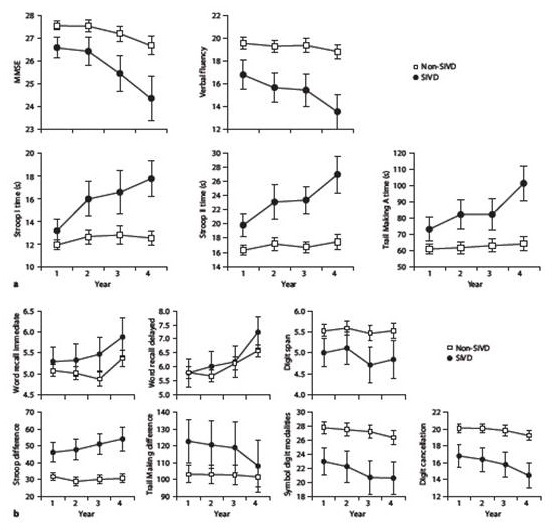 |
| Jokinen et al., Cerebrovasc Dis 2009 (LADIS Study) |
ApoE and vascular disease: A synergistic effect?
 |
| Rodrigue et al., JAMA Neurol 2013 |
Why is the vascular contribution to dementia and AD so important?
- Vascular disease is preventable
- Vascular disease is very common
- Therefore, this may be a way to prevent AD and other dementia cases
Prevention of vascular disease and AD
| USA |
Prevalence* |
PAR (95% CI) |
Number of attributable
cases in 2010 (95% CI)† |
| Diabetes mellitus |
10.3% |
4.5% (2.0-7.3) |
240 (107-389) |
| Midlife hypertension |
14.3% |
8.0% (2.2-15.1) |
435 (119-798) |
| Midlife obesity |
13.1% |
7.3% (4.3-10.8) |
386 (226-570) |
| Physical inactivity |
32.5% |
21.0% (5.8-36.6) |
1115 (308-1942) |
| Depression |
19.2% |
11.1% (7.5-15.0) |
588 (395-796) |
| Smoking |
20.6% |
10.8% (3.0-19.8) |
574 (159-1050) |
| Low educational attainment |
13.3% |
7.3% (4.4-10.3) |
386 (236-544) |
| Combined |
-- |
52.7% (25.9-72.8) |
2796 (1374-3858) |
| Adjusted combined |
-- |
30.6% (14.5-45.3) |
1622 (771-2401) |
| † in thousands |
Combined vascular risk factors account for 9.6 million additional cases of AD worldwide
 |
| From Norton et al., Lancet Neurology 2014 |
Future directions in the study of vascular contributors to Alzheimer’s Disease
- Evaluation of shared genetic risks, or differences in genetic factors that effect an individual’s susceptibility to vascular disease and/or AD
- Study of racial disparities in AD prevalence, which may be partially attributable to differences in vascular disease
- Use of neuroimaging, animal models to further explore mechanism of an additive versus synergistic effect of vascular disease and AD
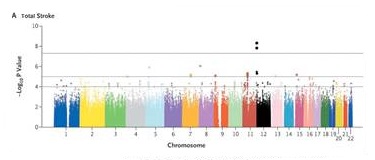 |
| NEJM 2009; 360(17):1718-28. |
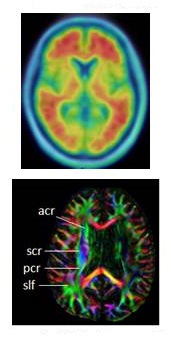 |
| Gottesman & Hillis, Lancet Neurology, 2010 |
Thanks for your attention.
